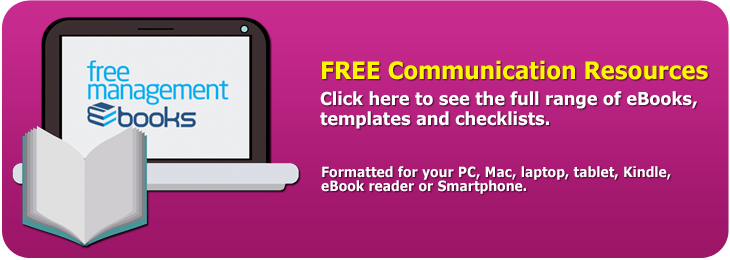Communication Skills - Define Your Key Message Statement
Sir William Lawrence Bragg, the youngest person ever to receive a Nobel Prize, was a distinguished presenter of scientific information to the public. Over one hundred years ago he wrote:
'If the average member of the audience can remember with interest and enthusiasm one main theme, the lecture has been a great success.'
He went on to say,
'I like to compare the composition of a lecture to that of a picture. Is it not held that a picture should have one main center of interest? It may have numerous subsidiary features, but the composition is so cunningly arranged that when the eye falls on these and follows their placing it is subtly led back to the main center of interest and does not fall out of the picture frame.'
Even though Sir William was referring to lectures, his advice is equally applicable to presentations. People remember very little of the information that is presented to them and it is unrealistic to expect your audience to remember more than one key message or theme.
With that in mind your best strategy is usually to choose your 'key' message carefully and to present only so much information to ensure that it is remembered. Don't forget you can always refer that percentage of your audience who require more detail to a supporting document.
So, how do you decide what your key message is? The best way is simply to take your presentation aim and to rephrase it in such a way that it engages the audience straightaway by making it clear that what you are about to say is important to them.
This will give you a key message statement. It does not need to be anything particularly clever or quotable, it just needs to make clear in as few words as possible why the audience should give you their full attention right now. The average workplace audience is polite and well behaved so you can pretty much guarantee that they will give you their undivided attention for about 30 seconds before they switch off, which most of them will if they think that what you are saying does not affect them directly.
The key message statement is what you would say if you only had ten seconds in which to say it. It's what you want the audience to remember. If, after your presentation, you were to ask a member of the audience to tell you the most important thing you were trying to communicate the answer should be the key message statement.
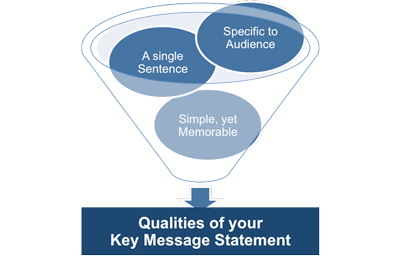 |
There are three characteristics your key message statement must have. It must:
1) Be created specifically for the audience
2) Be one sentence long
3) Be simple enough to be memorable
Some presentation books would lead you to believe that your presentation is doomed to failure if you do not have an attention-grabbing opening statement. This is just not true with regard to most business presentations where saying something that is obviously overstated will actually detract from your credibility.
Audiences will usually give politicians, evangelists, and salesmen a certain amount of license to make grandiose statements. But you need to be careful when 'grabbing' the attention of your team or senior management that you don't overdo it and 'grab' their attention for the wrong reasons.
This does not mean that that your key message statement is unimportant, but its value does need to be kept in perspective. If you are preparing a sales presentation then it is worth thinking up something compelling that appeals to the audience on an emotional level. Whereas when you are presenting to your own team it usually pays to be honest and objective rather than emotive.
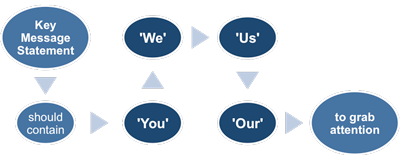 |
The key word here is 'usually.' There may come a time when you really do need to get your team to do something exceptional. This may be to work extra hours or accept some unpopular change to the way they work. In this instance, a key message statement with some emotional content will be effective in getting their attention because it will be novel and unexpected.
The most important words you can put into the key message statement are 'you' or 'we,' 'us' and 'our' in the context of this team, department, or organization.
The following tables show how presentation aims described earlier can be changed into key message statements by reframing them in a way that is 'audience-centric.' The following tables show how an aim statement is reworded into a key message statement depending on the audience.
Note that these key message statements are generic and in practice they would be modified to suit your own particular circumstances. For example:
'Our project will enable you to improve your productivity'
could become something like…
'How project Ajax will help you answer 9/10 customer queries first time'
 |
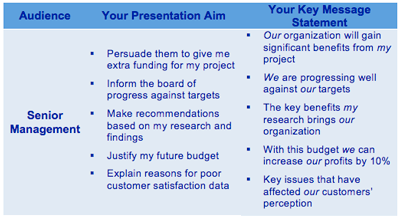 |
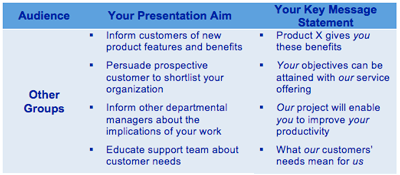 |
Key message statements do not need to be particularly clever. They are simply ways of stating your aim in a way that your audience can relate to because you are making it clear how it affects them personally.
Always set yourself a defined timeframe to come up with some options for your key message statement and then choose the best one. It is more important to spend time preparing your material and rehearsing it than to come up with something witty or dramatic.
More importantly, you can waste a lot of mental energy endlessly rewriting the statement when in reality it only needs to get the audience to pay attention to you at the beginning of your presentation. They will soon switch off if the content is irrelevant to them or if your delivery doesn't engage them, no matter how brilliant your opening statement may have been.
The key message statement has two purposes:
Firstly, it makes it easier for you to decide what to exclude from your presentation. It will help you to make quick decisions about what to include and what to omit.
Secondly, it will help you to write the introduction, summary, and conclusion of your presentation quickly and efficiently.
 |
As you work through the remaining planning stages, you may wish to change the original wording of your key message statement so that it better reflects your presentation's aim. This often happens because working through the planning process can make you see things in a new light. This is another reason not to spend too much time on the key message statement early on.
If you decide that it really is impossible to encapsulate the aim of your presentation in one key message statement then consider making more than one presentation. If the aim is sufficiently complicated to make one key message statement impossible, then it might be better to split the content into two or three separate presentations with a gap between each one.
This will involve some additional overhead, but it may be better than presenting two or three key messages that will dilute each other if you try to get them across in the same presentation.
Two or three shorter presentations, with a break between each one, give your audience the opportunity to focus their attention on each individual message. If your presentation aim really is that broad-reaching, then it may be that the whole audience does not need to hear all of it; splitting the presentation will give you the opportunity to present only the relevant parts to specific audiences, even if these overlap somewhat.
You may also be interested in:
Planning a Management Presentation | Everyday Management Presentations | Advantages and Disadvantages of Presentations | Four-Stage Presentation Planning Process | Audience Profiling | Presentation Environment | Outline the Scope of Your Presentation | Management Presentation Planning Guidelines.


